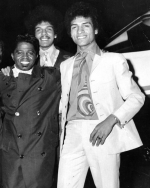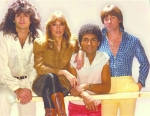
by MATTHEW HAYS
Pierre Perpall says that racism in Montreal in 1967 was a hard thing to pin down. Then a singer and dancer with several years of experience, Perpall and his manager were trying to get him on a local pop music show. Perpall said he had two strikes against him: he was local and he was black.
“Then, there really weren’t black artists on TV, unless they were from the U.S.,” he recalls. “Since I was black, the producers were nervous, because they didn’t know how the sponsors would take to it. They said that they had to ask the sponsors how they would take to it. It wasn’t so much that the producers didn’t want it, it was that they were afraid of the unknown.”
The son of a black jazz musician, Slim Perpall, and a white Québécoise, Pierre Perpall had always loved music and had been performing since he was a teenager. In the ’60s, he recalls, all of the black kids had seen what was going on in the U.S. and had formed their own bands. But in order to make it in the Quebec scene, you needed to cut a French album. So Perpall first performed the Johnny Mathis favourite “Chances Are” en français. “That didn’t go over so well,” he says now. “It wasn’t a hit.” But the second time came up lucky, when he sang “Pour moi ça va,” the French version of James Brown’s runaway hit “I Feel Good” in 1966. And that’s what led those TV producers to finally break with tradition and allow a local black performer onto the local airwaves.



“Once they did that, the barrier had been broken,” says Perpall, now 58. “Someone had dropped out and they needed a replacement. My manager had been phoning them every week to ask them about me. They took a chance, and then when they saw there was no bad reaction—no phone calls of protest—they realized they could do it.”
Colour codes
Those were fast and furious days for Perpall. With his records getting better play on the radio and more and more TV appearances, his star was rising. For all the excitement, Perpall knew he was being treated differently as a black performer.
“We grew up in a white neighbourhood in Montreal, so I knew what it meant to be different. In order to rent an apartment, my mother would always go and find one on her own. Then once she had the lease signed she’d show up with her three black kids. She knew she wouldn’t get the place if they’d seen us with her.”
The mid-to-late ’60s were good to Perpall. He had increasing radio play, live and recorded performances to his credit and was blazing a trail for black performers. But in ’69 something happened to the culture that changed his path. “After the first four or five years of your career, there’s always a drop. And then Woodstock happened, and my career really dropped. But I didn’t stop. I learned guitar. Then I wanted to be Jimi Hendrix. Which was good for me in a sense because I started touring the U.S. with a house band. That was a good apprenticeship, and I ended up working with a lot of great people, including B.B. King.”
But despite the advances made for blacks in the ’60s, and despite his own breakthroughs, Perpall still reports that the sting of racism was never too far behind—especially when touring the U.S. In 1969, Perpall got a gig performing at a hotel club in southern Florida. They set him up with a room in the hotel—that was, until his girlfriend came down from Montreal to join him. “When they saw that she was white, they put us in another room in another hotel. They wouldn’t tell me why they were doing it, but I pressed my manager about what was happening. He wouldn’t tell me either, until I forced him to. He said that if certain patrons saw I was with a white woman, there could be real trouble. It was hard to believe, but it was happening.”
Revolution through evolution
Looking at the vast photo collection that spans Perpall’s 40-year career, one gets the sense that he’s a phenomenal chameleon. After several years of touring with a house band, Perpall says his evolution would take another dramatic shift. It was 1977, and Saturday Night Fever had become a sensation at the box office. “All the agencies and record companies began calling, because they knew I danced and sang. They felt that if Travolta was a hit, and there was this black singer who could dance and sing, that that could work well. At that point, I didn’t really want to do disco records—I had been doing Santana and Joe Cocker. But I came back as a disco artist and recorded disco albums.”
Ironically, Perpall had originally made it in Quebec because he released a record in French. But by the ’70s, if Quebec recording artists wanted to bust out beyond the province’s borders, the trick was to do so in English—and in disco. Between ’76 and ’84, Perpall cut over 20 singles under various monikers, including Purple Flash (credited with the hit single “We Can Make It”) and—wait for it—Pluton and the Humanoids. As Pluton, Perpall cut his own single from outer space, the Giorgio Moroder-influenced “World Invaders.” For that song, he says, “I changed my voice to sound like a robot. But it didn’t take off in 1981, when I first released it.” More than 20 years later, a New York record company contacted Perpall and has commissioned the song for re-release. “Many people have contacted me through the Internet to tell me how much they love that song,” he reports.
Perpall has never stopped working. Now happily married and a proud grandfather, he has a tribute show to the hits of the ’50s and ’60s that he’ll be performing throughout March at the Montreal Casino. But as much as Perpall is a consummate professional, he’s also modest about his achievements as a trailblazer in Quebec. He does concede that having black musicians on stage and turning on white audiences has helped change overall race relations for the better. “We know that white people love music. And they love black music. Music has helped a lot in breaking down these barriers.